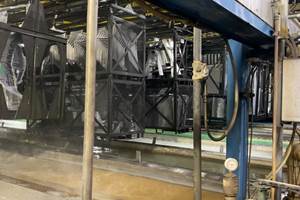Electrocoating Q&A: The Challenge of Zinc-Coated Steels
What are the differences in adhesion performance?
Q. We electrocoat galvanneal and other zinc-coated stamped parts for several automotive customers in a zinc phosphate and KTL monorail line. When we perform adhesion testing on parts, some show excellent results, but with others the adhesion results are borderline. Our process is the same for all parts, and the experiments we have performed do not show any process variability from part family to part family. How can you explain the differences in adhesion performance?
A. Often, zinc-coated steels present a challenge for electrocoat lines coating general parts for the industrial market. The challenge compounds if you supply electrocoated parts to multiple OEMs or Tier-One part suppliers and you receive zinc-coated steel parts made by different mills or provided under different specifications or requirements.
Because of personal experience with electrocoating zinc-coated steels for the automotive parts industry, I suspect the difference in adhesion performance between the multiple parts and customers you describe is due to the multiple surface post-treatments or sealers employed by the mill supplying the zinc-coated steel coil used by your customer to stamp the parts.
Post-treatments are applied to all zinc-coated steels to protect the freshly applied zinc metal from forming “white rust.” The post-treatments are always applied regardless of the zinc manufacturing process (hot dip galvanized GI, hot dip galvanneal GA, electrogalvanized and others).
Typical post-treatment processes for zinc-coated steels include the use of chromates to passivate the zinc surface and improve corrosion protection. They can be clear, yellow, black or iridescent. Other post-treatments are proprietary or registered formulas of non-chrome passivators or sealers that prolong the corrosion protection of the zinc-coated steel parts.
Post-treatments based on chrome are prohibited in the European automotive market as chrome is covered by the Life Vehicle Directive. Both chrome- and non-chrome-based post-treatments should be avoided in any location if further coating processes will be applied to the zinc-coated steel. Passivating and sealing post-treatment processes and materials should only be used when the zinc-coated steels will be used or left unpainted.
The third type of post-treatments to prevent the zinc-coated steel from corrosion while in transportation or manufacturing are rust preservatives (RPs) or light oils.
When the zinc-coated steel parts are to receive further finishing processes with reactive pretreatments such as zinc phosphate prior to electrocoat, only RPs and oil post-treatments should be used. This is because typical automotive cleaning systems cannot chemically remove the inorganic chrome or non-chrome post-treatment completely, preventing proper reaction between the zinc phosphate and the zinc-coated steel. The RPs and oils used must be compatible with typical automotive alkaline washers.
When full removal of the post-treatments is not accomplished, undesirable residual chemistry will remain on the surface of the zinc-coated steel and prevent good crystal nucleation and good phosphate coating weight development. Once the parts are electrocoated and cured, this “light, spotty, patchy and irregular” phosphate surface translates into marginal electrocoat adhesion, which is the adhesion problem that you describe.
The marginal electrocoat adhesion performance can be observed or detected by adhesion losses using typical bear claw adhesion tests, as well as bending, elongation or chipping tests performed on parts or cutout panels. Typically, the phosphate adhesion to the paint is better than to the zinc-coated steel surface, so phosphate crystals should be seen in the back of the delaminated paint under a 200× or greater magnification.
Communicate with the supplier of the zinc-coated steel and ask him to simply apply a rust preservative or oil for the necessary protection of the zinc-coated steel until electrocoating.
Oftentimes, material certifications or specifications must be approved and changed with the agreement of the automotive OEM and the steel supplier. This approach typically results in lower program costs, improved real life cosmetic and functional performance, a win-win for all.
Originally published in the September 2015 issue.
Related Content
Installing an Ecoat Line
Thinking of investing in electrocoating capabilities? George Lovell, coatings plant manager for Lippert, discusses considerations you should keep in mind as you add your ecoat line.
Read MoreProfessional Plating Expands Zinc, Ecoat Offerings
Ever expanding, Professional Plating of Brillion, Wisc., has announced two capital investments: a second zinc line and an upgrade of its ecoat capabilities.
Read MoreECOAT24 Attracts Both Serious Electrocoaters and Novices Alike
The conference, held April 2-4, 2024, in Orlando, Florida, provides the ecoating industry with educational sessions, supplier exhibits and networking with colleagues.
Read MoreSustainability, Electrification and Mobility
Industry events like ECOAT are good indicators of the trends that are top of mind for those in manufacturing.
Read MoreRead Next
Episode 45: An Interview with Chandler Mancuso, MacDermid Envio Solutions
Chandler Mancuso, technical director with MacDermid Envio discusses updating your wastewater treatment system and implementing materials recycling solutions to increase efficiencies, control costs and reduce environmental impact.
Read MoreEducation Bringing Cleaning to Machining
Debuting new speakers and cleaning technology content during this half-day workshop co-located with IMTS 2024.
Read MoreDelivering Increased Benefits to Greenhouse Films
Baystar's Borstar technology is helping customers deliver better, more reliable production methods to greenhouse agriculture.
Read More












.jpg;maxWidth=300;quality=90)












